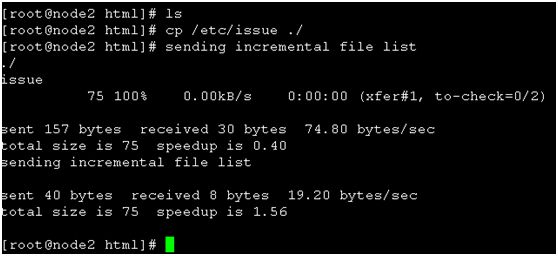Linux运维 第三阶段 (十四)rsync
Linux运维 第三阶段 (十四)rsync
一、相关概念:
rsync(remote synchronize,rsync.samba.org):远程数据同步工具,通过网络快速同步多台主机间的文件,也可使用rsync同步本地硬盘中不同目录中的数据,利用其自身算法(rsync算法)只传送两个文件的不同部分,通过ssh方式来传输文件,因此保密性好;与cp、tar备份方式相比,rsync具有安全性高、备份迅速、支持增量备份的优点,通过rsync可以解决对实时性要求不高的数据备份需求,如定期备份服务器数据到指定的服务器、对本地磁盘定期做数据镜像、集群中负载均衡后端real server的网页数据改动时同步到其它real server等场景
随着应用系统规模的不断扩大,对数据的安全性和可靠性也提出更高的要求,rsync在高端业务系统中暴露出了很多不足:rsync同步数据时,需要扫描所有文件后进行比对,进行差量传输,若文件数量达到了百万甚至千万量级,这将非常消耗系统性能而且低效,有时变化的数据往往只是很少的一部分;rsync不能实时的去监测、同步数据,虽然可以通过计划任务方式触发同步,但两次触发动作一定有时间差,这将导致服务端和客户端数据可能会不一致,通过inotify可解决此问题
inotify(是一种强大的、细粒度的、异步的FS事件监控机制,文件内容发生改变是内核管理的,内核将这种监控文件本身是否发生改变的功能输出给用户空间,用户空间才有可能知道,linux内核从2.6.13起支持inotify机制,通过inotify可以监控FS中添加、删除、修改、移动等各种细微事件,利用这个内核接口,通过第三方软件(inotify-tools)就可监控FS下文件的各种变化)
sersync(基于inotify开发,功能类似inotify,C++编写,多线程同步,sersync可以记录下被监听目录中发生变化的具体哪一个文件或哪个目录,然后使用rsync同步的时候,只同步发生变化的)
rsync+inotify与rsync-sersync两种架构的区别?
rsync+inotify(inotify监控FS的各种变化,一旦有变动时就触发rsync同步,解决了数据同步实时性的问题,inotify仅记录被监控的目录发生了变化,并没记录哪个目录或哪些文件发生了变化,所以rsync每次都要在被监控的所有目录和其下的文件与目标目录进行比对,再传输有差异的文件(要遍历目录下所有文件找出有差异的才进行同步),若数据量很大这将非常耗时,因此效率很低)
rsync+sersync(sersync可以记录被监控的目录中具体哪个目录哪些文件发生了变化,rsyc在同步时只同步发生变化的目录或文件,因此速度很快(节约时间)、节约带宽、效率很高)
注:若数据量不大建议使用rsync+inotify,若数据量很大建议使用rsync+sersync
二、操作:
1、rsync+inotify的实现
举例:实现两个web服务器的网页文件保持同步(一台为server,另一台为client,仅在server-side更新网页文件,查看client-side是否有同步,数据流向是server-->client)
准备软件:
rsync--3.0.9.tar.gz(https://rsync.samba.org/ftp/rsync/src/rsync-3.0.0.tar.gz)
inotify-tools-3.14.tar.gz(https://cloud.github.com/downloads/rvoicilas/inotify-tools/inotify-tools-3.14.tar.gz)
注:server-side安装rsync和inotify,client-side仅安装rsync
#ll /proc/sys/fs/inotify/(若此目录下有max_queued_events、max_user_instances、max_user_watches这三项则此内核支持inotify机制,内核2.6.13之后才支持此功能)
server-side(192.168.41.131):
#tar xf rsync-3.0.9.tar.gz
#cd rsync-3.0.9
#./configure --prefix=/usr/local/rsync
#make
#make install
#vim /etc/profile.d/rsync.sh
export PATH=$PATH:/usr/local/rsync/bin
#. !$
#vim /etc/man.config
MANPATH /usr/local/rsync/share/man
#man rsync
#rsync options SRC DET(rsync命令格式)
options:-vzrtopg
-v(--verbose)
-z(--compress)
-r(--recursive)
-t(--times)
-o(--owner)
-p(--perms)
-g(--group)
-a(--archive)
-A(--acls)
-H(--hard-links)
-l(--links)
-D(--devices --specials)
--delete(delete extraneousfiles from dest dirs,删除目标位置有而原始位置没有的文件)
--progress(show progress duringtransfer显示传输过程)
--passwd-file=FILE(readdaemon-access password from FILE,指定密钥文件)
#echo "redhat" > /usr/local/rsync/rsync.passwd(建立认证文件,密码为redhat,此处不需要用户名)
#chmod 600 !$(为安全,将密码文件权限改为600)
#tar xf inotify-tools-3.14.tar.gz
#cd inotify-tools-3.14
#./configure --prefix=/usr/lcoal/inotify
#make
#make install
#vim /etc/profile.d/inotify.sh
export PATH=$PATH:/usr/local/inotify/bin
#. !$
#vim /etc/man.config
MANPATH /usr/local/inotify/share/man
#man inotifywatch(gather filesystem access statistics using inotify,用于短期监控,任务完成后再出结果)
#man inotifywait(wait for changes to files using inotify,用于持续监控,实时输出结果)
#inotifywait -mrq -e EVENT --timefmt FMT --format FMT FILE(inotifywait命令用法)
-m(--monitor)
-r(--recursive)
-q(--quiet)
-e(--event,Listen forspecific event(s) only)
--timefmt
--format(Output in a user-specified format)
EVENT有:
modify(A watched file or afile within a watched directory was written to)
delete(A file or directorywithin a watched directory was deleted)
create(A file or directorywas created within a watched directory)
attrib(The metadata of awatched file or a file within a watched directory was modified)
move(A file or directorywas moved from or to a watched directory)
#vim /root/rsync.sh
#!/bin/bash
#
host=192.168.41.132
src=/var/www/html/
des=test
user=testuser
/usr/local/inotify/bin/inotifywait -mrq --timefmt ‘%d/%m/%y %H:%M’ --format ‘%T %w%f%e’ -e modify,delete,create,attrib $src | while read files;do
/usr/bin/rsync -vzrtopg --delete --progress --passwd-file=/usr/local/rsync/rsync.passwd $src $user@$host::$des
echo “${files} was rsynced” >> /var/log/rsync.log 2>&1
done
#chmod 764 /root/rsync.sh
#sh /root/rsync.sh &(注意!待client-side启动rsync服务后再运行此脚本)
client-side(192.168.41.132):
#tar xf rsync-3.0.9.tar.gz
#cd rsync-3.0.9
#./configure --prefix=/usr/local/rsync
#make
#make install
#vim /etc/profile.d/rsync.sh
export PATH=$PATH:/usr/local/rsync/bin
#. !$
#vim /etc/man.config
MANPATH /usr/local/rsync/share/man
#echo "testuser:redhat" > /usr/local/rsync/rsync.passwd(建立认证文件)
#chmod 600 !$(为安全,将密码文件权限改为600)
#vim /usr/local/rsync/rsync.conf
uid = root
gid = root
use chroot = no(默认为true,增加对目录文件软链接的备份)
max connections = 10
timeout = 600
strict modes = yes
pid file = /var/run/rsyncd.pid
lock file = /var/log/rsyncd.lock
log file = /var/log/rsyncd.log
motd file = /etc/rsyncd.motd(可在此文件中编辑启动时的欢迎信息)
[test](自定义名称)
path = /var/www/html/(数据同步到本地的目录路径)
comment = test(描述信息)
ignore errors = yes
read only = no(设置rsync服务端文件为读写权限)
hosts allow = 192.168.41.131(允许进行数据同步的主机地址,多个用逗号隔开)
hosts deny = *(禁止数据同步的主机地址)
list = false(不显示rsync服务端资源列表)
uid = root(设置rsync运行权限)
gid = root
port = 873(默认端口)
auth users = testuser(执行数据同步的用户名,可以设置多个用逗号隔开)
secrets file =/user/local/rsync/rsync.passwd(用户认证配置文件,里面包含用户名和密码)
#rsync --daemon --config=/usr/local/rsync/rsync.conf(启动rsync)
测试:
server-side(/var/www/html下):

client-side(/var/www/html下):

2、rsync+sersync的实现:
server-side:
参照上例,安装rsync、制作认证文件并改权限为600
#mkdir /usr/local/sersync/
# tar -xf sersync_64bit_binary_stable_final.tar.gz
#cd GNU-Linux-x86
#mv confxml.xml sersync2 /usr/local/sersync/
#cd /usr/local/sersync
#cp confxml.xml confxml.xml.bak
#vim confxml.xml
……
<sersync>
<localpath watch="/var/www/html">
<remote ip="192.168.41.132" name="test"/>
<!--<remote ip="192.168.8.39" name="tongbu"/>-->
<!--<remote ip="192.168.8.40" name="tongbu"/>-->
</localpath>
<rsync>
<commonParams params="-vzrtopg"/>
<auth start="true" users="testuser" passwordfile="/usr/local/rsync/rsync.passwd"/>
<userDefinedPort start="false"port="874"/><!-- port=874 -->
<timeout start="false" time="100"/><!--timeout=100 -->
<ssh start="false"/>
</rsync>
<failLog path="/tmp/rsync_fail_log.sh" timeToExecute="60"/><!--default every 60mins execute once-->
<crontab start="true"schedule="600"><!--600mins-->
<crontabfilter start="false">
<exclude expression="*.php"></exclude>
<exclude expression="info/*"></exclude>
</crontabfilter>
</crontab>
<plugin start="false" name="command"/>
</sersync>
……
#vim /root/check_sersync.sh
#!/bin/bash
#
SERSYNC="/usr/local/sersync/sersync2"
CONF_FILE="/usr/local/sersync/confxml.xml"
STATUS=`ps aux | grep 'sersync2' | grep -v'grep' | wc -l`
if [ $STATUS -eq 0 ];then
$SERSYNC -d -r -o $CONF_FILE &
else
exit 0;
fi
#crontab -e(为防止sersync2意外中断,每5分钟使用此脚本检测,若sersync2未运行,则会自动开启,进行实时同步)
*/5 * * * * bash /root/check_sersync.sh&> /dev/null
#/usr/local/sersync/sersync2 -d -r -o /usr/local/sersync/confxml.xml(开启sersync服务)
-d(run as a daemon)
-r(rsync all the localfiles to the remote servers before the sersync work)
-o(config xml name: ./confxml.xml)
client-side:
参照上例,安装rsync,配置rsync.conf文件,配置认证文件,并开启rsync服务
测试:
server-side:


client-side:

以上内容是自找资料整理。
本文出自 “Linux运维重难点学习笔记” 博客,谢绝转载!